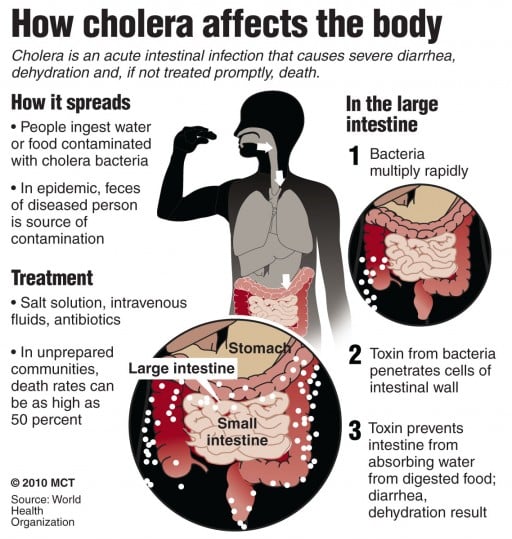
University of Oreogn, Lillis Buisness Complex http://www.dailyemerald.com/wp-content/uploads/2013/10/JK_9037A.jpg
The cholera outbreak that hit the University of Oregon campus (Eugene, Oregon) prior to Halloween this year was not a treat. A campus known for its academic research and enthusiastic sports fans were saddened by fatalities numbering more than 70, making it the largest outbreak in the US in recent years. According to the CDC (Centers for Disease Control and Prevention), there are on average 0-5 cases each year that occur in the US, reportedly due to food contamination international travel (WHO, 2015).

Cholera: Vibrio cholerae bacteria http://cdn.phys.org/newman/gfx/news/hires/cholerastrai.jpg
What is Cholera?
Cholera is a highly contagious, Vibrio cholerae, bacterial infection with an incubation period of five days or less. The bacteria can be transmitted through contaminated water sources and feces of an infected person which can preserve the bacteria for up to 10 days (WHO, 2015). Symptoms only appear in 1 in every 10 infected people. Those that develop severe symptoms can have severe dehydration, extreme diarrhea, vomiting, and death within hours if left untreated (CDC, 2015). Cholera is treatable with Rehydration therapy, and antibiotic treatment. (CDC, 2015).
According to the CDC, the Word Health Organization (WHO), keeps track of global epidemics and they states that cholera is “a major cause of epidemic diarrhea” developing world (CDC, 2015). Cholera has been an ongoing concern in Iraq since 2012, with more than 1,800 cases and six deaths. Health officials have linked this outbreak to the contaminated Euphrates river, which many locals depend on for farming, drinking, and bathing (Hameed and Coles, 2015).

http://preparednessadvice.com/wp-content/uploads/2015/06/cholera2.jpg
Preventative Actions
- Drink/ Use safe water
- Wash hands with soap and safe water
- Use toilets or bury waste (away from bodies of water)
- Cook food well
- Clean up safely
What occurred at the United States campus?
The first Tweet occurred on the 22nd of October , posted by Anonymous who felt “a little under the weather”. The following day was the first University of Oregon’s Alert on Facebook, notifying the campus of the unknown illness going around. On October 26th the news about the first victims of the outbreak was broadcast on Facebook. In the evening of October 30th the University of Oregon Facebook Alerts let it be known that the outbreak contaminated source of contained.
The outbreak was likely due to an accidental contamination of water sources in the southwest area of campus. In scope, infected individuals were restricted to those that came into contact with University water sources in the restrooms near Aasen Hull hall, located within the Frohnmayer Music building.
As we go into the holiday season, we remember those who were victims of this horrible outbreak. The University of Oregon has released the last names of the following deceased professors, who were all located at the Frohnmayer school of Music and Dance: Dr. Baird, Dr. Dorsey, Dr. Park, and Dr. Wolf. Other names will be released upon approval of next of kin.
A map analysis of confirmed deaths on the campus (created by Alma Zurita) is available in the menu above, as well as a map related to the University’s Facebook Alerts (created by Scott Powers), and a map of local tweets (created by Mikayla Steele).
GEOG 181 Group #19: Alma Zurita, Scott Powers, Mikayla Steele
Works Cited
CDC, Center for Disease Control. 2014. Cholera. October 27. Accessed October 30, 2015. http://www.cdc.gov/cholera/index.html.
Hameed, Saif, and Isabel Coles. “Iraq’s Cholera Outbreak Exceeds 1,800 Cases: Health Ministry.” Reuters. N.p., 21 Oct. 2015. Web. 2015.
WHO, World Health Organization. 2015. Media Centre- Cholera fact sheet. Accessed October 30, 2015. http://www.who.int/mediacentre/factsheets/fs107/en/.